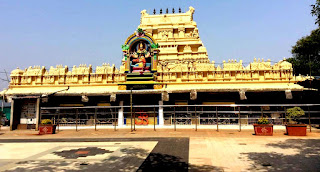The Bhadrakali Temple of Warangal, Telengana is a historical temple and is closely associated with the Kakatiya dynasty of this place who once owned the world famous Koh-i-noor diamond. The Kakatiya kingdom covered most of the Telugu speaking lands (part of present day Telangana and Andhra Pradesh states). Their dynasty reigned between 1083 CE to 1323 CE, with Orugallu (now Warangal), as its capital and possessed this most expensive diamond in the world.
 |
| Bhadrakali temple, Warangal, Telengana. warangaltourism.in |
Bhadrakali Temple atop a hill between two cities of Hanamkonda and Warangal, Telangana, is one of the oldest temples dedicated to Goddess Bhadrakali, a Hindu goddess quite popular in Southern India, especially in Kerala.
 |
| Bhadrakali temple, Warangal. Telanganafamoustemples.com |
One of the fierce forms of the primary Goddess Shakti or Adi Parashakti, she is actually an epitome of compassion and love for her devotees and. at the same time. a destroyer of evil forces or men with devil's mind. She often goes by different names: Durga, Devi, Mahadevi, or Mahamaya mentioned in the Devi Mahatmyam. She is known in Kerala as Bhagavati, Mahakali and Chamunda and is often seen as the auspicious and fortunate form of Mahakali. More often than not her worship and rituals are associated with the Tantric tradition of the Matrikas as in Kerala or of the tradition of the ten Mahavidyas and falls under the broader purview of Shaktism.
 |
| Location map. Warangal, Telengana. .mapsofindia.com |
Bhadrakali (Maha Kali Mata) was the principal deity of the Hindu Kakatiya kingdom of Warangal and it was a tradition among the Kakatiya rulers to invoke her blessings before going on a war campaign. According to temple inscriptions, the temple was built in 625 A.D by the King Pulakeshi II to commemorate his victory over Vengi region of Andhra Desham. After this decisive victory later rulers of this dynasty considered Goddess Bhadrakali as their "Kula Devatha"(family deity).
The stone image (2.7 x 2.7 m2) of goddess Kali in the sanctum- garbagriha is in her fierce form - with large eyes, stern look, and eight arms wielding different weapons. She sits on the lion, her vahana/ mount. The subtle conception is she is the slayer of evil men and spirits. The Lion image is facing the sanctum sanctorum. Temple also has Dwajasthambam and a Balipeetam like other temples. .
Unfortunately the temple lost its prominence and glory with the fall of Kakatiya dynasty in the face of a raid by the Delhi Sultanate of Allauddin Khilji in the 1300s. The Kakatiya army was unprepared for this sudden raid. The ruler made a deal with the Sultan and accordingly, as part of the truce, he handed over his brilliant diamond to Sultan's representative, personal confidant and Army head Malik Kufur ( some historians say it was Army chief Ulugh Khan). That intriguing diamond the world famous Kohinoor diamond looted by the East India company from India in 1839; With 793 carats in weight when uncut it was the biggest diamond in the world then. It is said that the Kakatiya rulers installed the diamond as the third eye of Bhadrakali. According the Hindu mythology the goddess has three eyes and many arms to fight with demonic forces.
Yet another version says that the Sultanate army in 1310 raided this place, destroyed the Bhadrakali temple and took away the diamond.
 |
| Koh-i-noor diamond of kakatiya origin, India en.wikipedia.org |
 |
| Koh-i-noor diamond on British queen' crown. theguardian.com/ |
Above images : Koh-i-Noor Diamond: Present owner the royal British family since 1949. Koh-i-noor diamond (mountain of light) is on the British Queen's crown; last seen in 2002 on the coffin of queen mother. It is on display along with other Royal jewelry in the Tower of London. Until 1839 it was with Sikh Maharajah Ranjit Singh of Punjab. He died in 1829, leaving his kingdom with his minor son and heir Duleep Singh (just 10 years old) and his wife. The cunning British company officials who had already eyed on the rich kingdom, violently forced the queen Regent Rani Jind Kaur and her son in 1849 to sign over the kingdom along with Koh-i-noor and a red-colored Timur Spinal ( 353.5 ct largest stone in the world). Mined in the Kollur diamond mines near Gunter, AP, it is the size of a hen's egg. original weight: 793 ct; later cut to 105 ct.................
Believed to have been worn by Goddess Bhadrakali, the diamond carried a curse: ''Only God and woman can can wear it with impunity.'' Any man wearing it would die. After Bhadrakali, only queen Elizabeth wore it for a long time without any harm. As for Allauddin Khilji who looted the diamond was in the later years was killed by his own slave Malik Kaufer.
It was in 1950, the temple was renovated under the guidance of Devi Opasakar Sri Ganesh Rao Sastri, Gujarati Businessman shri Maganlal. B. Sameja made vast conribution to this temple. Founder of Shri Bhadrakali Temple. Here Apara Ekadashi is observed as Goddess Bhadrakali Ekadashi.
Close by there is an artificial lake called Bhadrakali lake established by King Ganapiti Deva. It is a big lake covering 2.5 km2; mostly used for irrigation purpose.
.The temple can be accessed from Warangal and Kazipet railway stations. There re buses available to this temple from nearby places.
https://en.wikipedia.org/wiki/Bhadrakali_Temple,_Warangal





.jpg)



.jpeg)